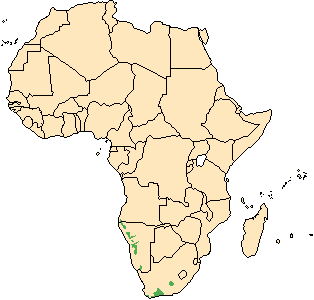![]() Return
to Perissodactyla
Return
to Perissodactyla
Classification
|
 Equus
zebra
Equus
zebra
Mountain zebra
![]()
Taxonomy
 |
 |
 |
Click on the pictures above for a larger view of the
photographs
|
||
General Characteristics
Body Length: 220 cm / 7.3 ft.
Shoulder Height: 120-130 cm / 4-4.3 ft.
Tail Length: 50 cm / 20 in.
Weight: 260-370 kg / 572-814 lb.The mountain zebra's coat is characterized by its series of black and white stripes. These vertical lines are thin and relatively close together on the neck and torso, but on the haunches they change into a few wide, horizontal bars. The striping on the legs is composed of very fine, horizontal bands which may circle the entire limb. The rear spine and upper tail are marked with a zipper-type grid-iron pattern - the most easily recognizable feature of the mountain zebra. The undersides are a creamy white, interrupted by a dark stripe which runs the length of the belly. There is a hanging flap of skin on the upper neck which is reminiscent of an Adam's apple. The stiff, upright mane on the nape is striped continuously with the neck. The head is relatively short, also striped, but with a dark muzzle, and the ears are long, marked with bold black and white patches. A long, flowing tassel of white and black hair is found along the lower half of the tail.
Ontogeny and Reproduction
Gestation Period: 12 months.
Young per Birth: 1
Weaning: 10 months.
Sexual Maturity: 2 years.
Life span: At least 25 years.Breeding occurs throughout the year, although there a regional peaks in births
Ecology and Behavior
The mountain zebra is diurnal, with feeding consuming more than half of the daylight hours. Peaks of activity occur in the early morning and late afternoon. Dust baths are taken frequently - generally once or twice daily. The name mountain zebra is very appropriate - these animals are excellent rock climbers and are much more sure-footed on steep or rugged surfaces than their plains relatives. A distinct hierarchy is maintained within a breeding band, with the dominant adult stallion responsible for defending the herd. Breeding groups use a home range which varies from 3.1-20 square kilometers in area. These home ranges overlap among groups, with no evidence of territoriality. Adult stallions may become aggressive if two bands meet, although these may also join temporarily into a larger group, rarely exceeding 30 animals in size. Vocalizations consist of a high-pitched alarm call, and a squeal indicating submission.Family group: Small herds led by an adult male and 1-6 females and their young, other males in bachelor herds.
Diet: Grasses, bark, leaves.
Main Predators: Lion, hyena
Distribution
Deserts and semideserts of southwestern Africa.

Range Map (Redrawn from IEA, 1998)
Conservation Status
The mountain zebra as a species is classified as endangered, with both E. z. hartmannae and E. z. zebra falling under this same classification.
Remarks
Equus (Latin) a horse. The source of zebra is obscure, probably from the Abyssinian word zibra meaning striped.
Literature Cited
IEA (Institute of Applied Ecology). 1998. Equus zebra. In African Mammals Databank - A Databank for the Conservation and Management of the African Mammals Vol 1 and 2. Bruxelles: European Commission Directorate. Available online at http://gorilla.bio.uniroma1.it/amd/amd136b.htmlKingdon, J. 1997. The Kingdon field guide to African Mammals. Academic Press, London and New York: Natural World.
Klingel, H. 1990. Horses. In Grzimek's Encyclopedia of Mammals. Edited by S. P. Parker. New York: McGraw-Hill. Volume 4, pp. 557-594.
Nowak, R. M. [editor]. 1991. Walker's Mammals of the World (Fifth Edition). Baltimore: The Johns Hopkins University Press.
Wilson, D. E., and D. M. Reeder [editors]. 1993. Mammal Species of the World (Second Edition). Washington: Smithsonian Institution Press. Available online at http://nmnhwww.si.edu/msw/
Return to Perissodactyla

![]()
© Brent Huffman, www.ultimateungulate.com |
|
|